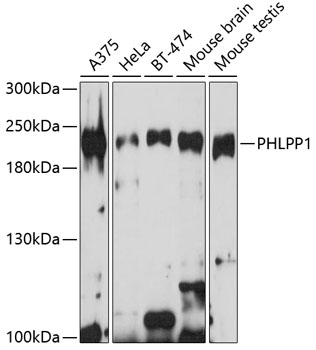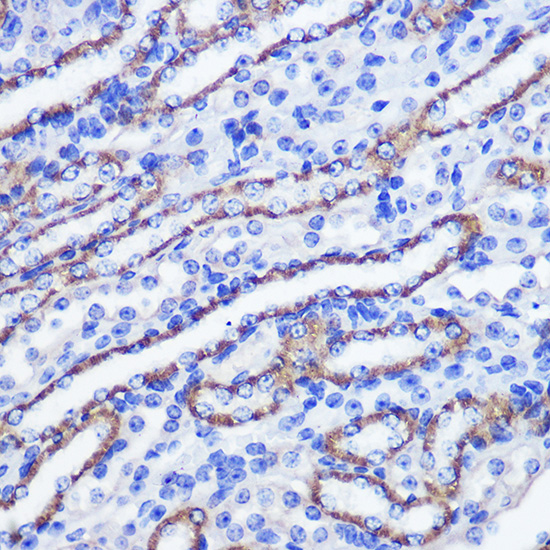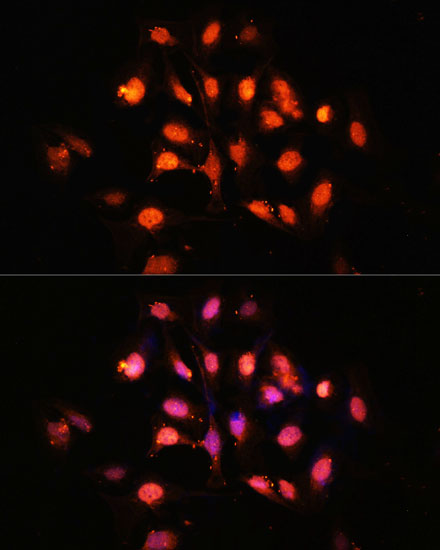Cell Death Antibodies 2
Anti-PHLPP1 Antibody (CAB9542)
- SKU:
- CAB9542
- Product Type:
- Antibody
- Applications:
- WB
- Applications:
- IHC
- Applications:
- IF
- Reactivity:
- Human
- Reactivity:
- Mouse
- Reactivity:
- Rat
- Host Species:
- Rabbit
- Isotype:
- IgG
- Research Area:
- Cell Death
Description
| Antibody Name: | Anti-PHLPP1 Antibody |
| Antibody SKU: | CAB9542 |
| Antibody Size: | 20uL, 50uL, 100uL |
| Application: | WB IHC IF |
| Reactivity: | Human, Mouse, Rat |
| Host Species: | Rabbit |
| Immunogen: | Recombinant fusion protein containing a sequence corresponding to amino acids 1508-1717 of human PHLPP1 (NP_919431.2). |
| Application: | WB IHC IF |
| Recommended Dilution: | WB 1:500 - 1:2000 IHC 1:50 - 1:200 IF 1:50 - 1:200 |
| Reactivity: | Human, Mouse, Rat |
| Positive Samples: | A375, HeLa, BT-474, Mouse brain, Mouse testis |
| Immunogen: | Recombinant fusion protein containing a sequence corresponding to amino acids 1508-1717 of human PHLPP1 (NP_919431.2). |
| Purification Method: | Affinity purification |
| Storage Buffer: | Store at -20'C. Avoid freeze / thaw cycles. Buffer: PBS with 0.02% sodium azide, 50% glycerol, pH7.3. |
| Isotype: | IgG |
| Sequence: | PAYP SEQR CMLH PICL SNSF QRQL SSAT FSSA FSDN GLDS DDEE PIEG VFTN GSRV EVEV DIHC SRAK EKEK QQHL LQVP AEAS DEGI VISA NEDE PGLP RKAD FSAV GTIG RRRA NGSV APQE RSHN VIEV ATDA PLRK PGGY FAAP AQPD PDDQ FIIP PELE EEVK EIMK HHQE QQQQ QQPP PPPQ LQPQ LPRH YQLD QLPD YYDT PL |
| Gene ID: | 23239 |
| Uniprot: | O60346 |
| Cellular Location: | Cell membrane, Cytoplasm, Membrane, Nucleus, Peripheral membrane protein |
| Calculated MW: | 133kDa/184kDa |
| Observed MW: | 185kDa |
| Synonyms: | PHLPP1, PHLPP, PLEKHE1, PPM3A, SCOP |
| Background: | This gene encodes a member of the serine/threonine phosphatase family. The encoded protein promotes apoptosis by dephosphorylating and inactivating the serine/threonine kinase Akt, and functions as a tumor suppressor in multiple types of cancer. Increased expression of this gene may also play a role in obesity and type 2 diabetes by interfering with Akt-mediated insulin signaling. |
| UniProt Protein Function: | PHLPP: a pleckstrin homology domain leucine-rich repeat protein phosphoserine and ¿threonine phosphatase. A tumor suppressor that controls the onset and progression of various cancers because it controls the balance between cell survival and apoptosis. Catalyzes the dephosphorylation of the hydrophobic motif on the AGC kinases Akt, PKC, and S6 kinase, and the inhibitory site on the kinase Mst1. The dephosphorylation of PKCA and PKCB is destabilizing, leading to its degradation. The dephosphorylation of p70S6K at T390 reduces its activity, thus reducing the efficiency of protein translation. Dephosphorylation of Mst1 by PHLPP of an autoinhibitory site (T387) activates Mst1, resulting in the activation of the pro-apoptotic MAPK pathway. Ubiquitously expressed in non-cancerous tissues. Insensitive to inhibition by okadaic acid. PHLPP loss occurs at high frequency in colorectal cancer, and leads to the development of prostate tumors in mice. PHLPP degradation by the 26 S proteasome is controlled by a beta-TrCP-containing Skp¿Cullin 1¿F-box protein (SCF) complex E3 ubiquitin ligase in a phosphorylation-dependent manner. This degradation requires phosphorylation of PHLPP1 by CK I and GSK-3beta. Activation of the PI3K/Akt pathway suppresses the degradation of PHLPP1 by inhibiting GSK-3beta activity. PHLPP2 activity is highly sensitive to a common polymorphism (L-1016-S) that reduces its rate of dephosphorylation of the hydrophobic motif of Akt and PKC, rendering it ineffective at inducing apoptosis. This variant is expressed by 30% of the human population. Interacts with the nucleotide free form of KRas via its LRR repeats. Interacts with AKT2, AKT3 and PKCB isoform beta-II. |
| UniProt Protein Details: | Protein type:Tumor suppressor; Protein phosphatase, Ser/Thr (non-receptor); EC 3.1.3.16 Chromosomal Location of Human Ortholog: 18q21.33 Cellular Component: cytosol Molecular Function:protein binding Biological Process: negative regulation of protein kinase B signaling cascade; regulation of apoptosis; regulation of JNK cascade; regulation of MAPKKK cascade |
| NCBI Summary: | This gene encodes a member of the serine/threonine phosphatase family. The encoded protein promotes apoptosis by dephosphorylating and inactivating the serine/threonine kinase Akt, and functions as a tumor suppressor in multiple types of cancer. Increased expression of this gene may also play a role in obesity and type 2 diabetes by interfering with Akt-mediated insulin signaling. [provided by RefSeq, Dec 2011] |
| UniProt Code: | O60346 |
| NCBI GenInfo Identifier: | 67460982 |
| NCBI Gene ID: | 23239 |
| NCBI Accession: | O60346.3 |
| UniProt Secondary Accession: | O60346,Q641Q7, Q6P4C4, Q6PJI6, Q86TN6, Q96FK2, Q9NUY1 A1A4F5, |
| UniProt Related Accession: | O60346 |
| Molecular Weight: | 133,565 Da |
| NCBI Full Name: | PH domain leucine-rich repeat-containing protein phosphatase 1 |
| NCBI Synonym Full Names: | PH domain and leucine rich repeat protein phosphatase 1 |
| NCBI Official Symbol: | PHLPP1 |
| NCBI Official Synonym Symbols: | SCOP; PHLPP; PPM3A; PLEKHE1 |
| NCBI Protein Information: | PH domain leucine-rich repeat-containing protein phosphatase 1 |
| UniProt Protein Name: | PH domain leucine-rich repeat-containing protein phosphatase 1 |
| UniProt Synonym Protein Names: | Pleckstrin homology domain-containing family E member 1; PH domain-containing family E member 1; Suprachiasmatic nucleus circadian oscillatory protein; hSCOP |
| Protein Family: | PH domain leucine-rich repeat protein phosphatase |
| UniProt Gene Name: | PHLPP1 |
| UniProt Entry Name: | PHLP1_HUMAN |
View AllClose









